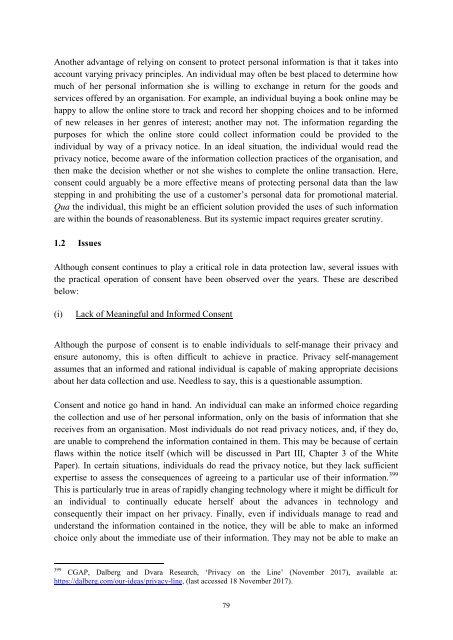white_paper_on_data_protection_in_india_171127_final_v2
Create successful ePaper yourself
Turn your PDF publications into a flip-book with our unique Google optimized e-Paper software.
Another advantage of rely<strong>in</strong>g <strong>on</strong> c<strong>on</strong>sent to protect pers<strong>on</strong>al <strong>in</strong>formati<strong>on</strong> is that it takes <strong>in</strong>to<br />
account vary<strong>in</strong>g privacy pr<strong>in</strong>ciples. An <strong>in</strong>dividual may often be best placed to determ<strong>in</strong>e how<br />
much of her pers<strong>on</strong>al <strong>in</strong>formati<strong>on</strong> she is will<strong>in</strong>g to exchange <strong>in</strong> return for the goods and<br />
services offered by an organisati<strong>on</strong>. For example, an <strong>in</strong>dividual buy<strong>in</strong>g a book <strong>on</strong>l<strong>in</strong>e may be<br />
happy to allow the <strong>on</strong>l<strong>in</strong>e store to track and record her shopp<strong>in</strong>g choices and to be <strong>in</strong>formed<br />
of new releases <strong>in</strong> her genres of <strong>in</strong>terest; another may not. The <strong>in</strong>formati<strong>on</strong> regard<strong>in</strong>g the<br />
purposes for which the <strong>on</strong>l<strong>in</strong>e store could collect <strong>in</strong>formati<strong>on</strong> could be provided to the<br />
<strong>in</strong>dividual by way of a privacy notice. In an ideal situati<strong>on</strong>, the <strong>in</strong>dividual would read the<br />
privacy notice, become aware of the <strong>in</strong>formati<strong>on</strong> collecti<strong>on</strong> practices of the organisati<strong>on</strong>, and<br />
then make the decisi<strong>on</strong> whether or not she wishes to complete the <strong>on</strong>l<strong>in</strong>e transacti<strong>on</strong>. Here,<br />
c<strong>on</strong>sent could arguably be a more effective means of protect<strong>in</strong>g pers<strong>on</strong>al <strong>data</strong> than the law<br />
stepp<strong>in</strong>g <strong>in</strong> and prohibit<strong>in</strong>g the use of a customer‘s pers<strong>on</strong>al <strong>data</strong> for promoti<strong>on</strong>al material.<br />
Qua the <strong>in</strong>dividual, this might be an efficient soluti<strong>on</strong> provided the uses of such <strong>in</strong>formati<strong>on</strong><br />
are with<strong>in</strong> the bounds of reas<strong>on</strong>ableness. But its systemic impact requires greater scrut<strong>in</strong>y.<br />
1.2 Issues<br />
Although c<strong>on</strong>sent c<strong>on</strong>t<strong>in</strong>ues to play a critical role <strong>in</strong> <strong>data</strong> protecti<strong>on</strong> law, several issues with<br />
the practical operati<strong>on</strong> of c<strong>on</strong>sent have been observed over the years. These are described<br />
below:<br />
(i)<br />
Lack of Mean<strong>in</strong>gful and Informed C<strong>on</strong>sent<br />
Although the purpose of c<strong>on</strong>sent is to enable <strong>in</strong>dividuals to self-manage their privacy and<br />
ensure aut<strong>on</strong>omy, this is often difficult to achieve <strong>in</strong> practice. Privacy self-management<br />
assumes that an <strong>in</strong>formed and rati<strong>on</strong>al <strong>in</strong>dividual is capable of mak<strong>in</strong>g appropriate decisi<strong>on</strong>s<br />
about her <strong>data</strong> collecti<strong>on</strong> and use. Needless to say, this is a questi<strong>on</strong>able assumpti<strong>on</strong>.<br />
C<strong>on</strong>sent and notice go hand <strong>in</strong> hand. An <strong>in</strong>dividual can make an <strong>in</strong>formed choice regard<strong>in</strong>g<br />
the collecti<strong>on</strong> and use of her pers<strong>on</strong>al <strong>in</strong>formati<strong>on</strong>, <strong>on</strong>ly <strong>on</strong> the basis of <strong>in</strong>formati<strong>on</strong> that she<br />
receives from an organisati<strong>on</strong>. Most <strong>in</strong>dividuals do not read privacy notices, and, if they do,<br />
are unable to comprehend the <strong>in</strong>formati<strong>on</strong> c<strong>on</strong>ta<strong>in</strong>ed <strong>in</strong> them. This may be because of certa<strong>in</strong><br />
flaws with<strong>in</strong> the notice itself (which will be discussed <strong>in</strong> Part III, Chapter 3 of the White<br />
Paper). In certa<strong>in</strong> situati<strong>on</strong>s, <strong>in</strong>dividuals do read the privacy notice, but they lack sufficient<br />
expertise to assess the c<strong>on</strong>sequences of agree<strong>in</strong>g to a particular use of their <strong>in</strong>formati<strong>on</strong>. 399<br />
This is particularly true <strong>in</strong> areas of rapidly chang<strong>in</strong>g technology where it might be difficult for<br />
an <strong>in</strong>dividual to c<strong>on</strong>t<strong>in</strong>ually educate herself about the advances <strong>in</strong> technology and<br />
c<strong>on</strong>sequently their impact <strong>on</strong> her privacy. F<strong>in</strong>ally, even if <strong>in</strong>dividuals manage to read and<br />
understand the <strong>in</strong>formati<strong>on</strong> c<strong>on</strong>ta<strong>in</strong>ed <strong>in</strong> the notice, they will be able to make an <strong>in</strong>formed<br />
choice <strong>on</strong>ly about the immediate use of their <strong>in</strong>formati<strong>on</strong>. They may not be able to make an<br />
399<br />
CGAP, Dalberg and Dvara Research, ‗Privacy <strong>on</strong> the L<strong>in</strong>e‘ (November 2017), available at:<br />
https://dalberg.com/our-ideas/privacy-l<strong>in</strong>e, (last accessed 18 November 2017).<br />
79














